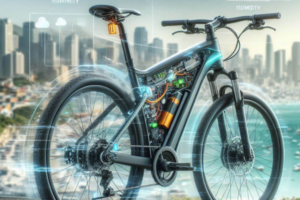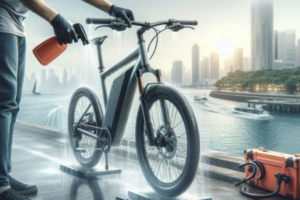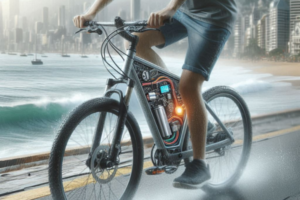🌊 Why Coastal Areas Present Unique Challenges for E-Bike Efficiency
Electric bicycles are an excellent solution for sustainable transport in coastal regions. They offer silent mobility, zero emissions, and convenience in areas where short distances and scenic routes encourage daily use. However, the very environment that makes coastal cities attractive also presents challenges to the energy efficiency of e-bikes.
Humidity, salt air, temperature shifts, and terrain variability all affect how much energy your electric bicycle consumes — and how quickly components wear down. Riders living in places like Cartagena, Miami, or Lisbon face a unique equation: enjoy the coast’s beauty while fighting its slow, invisible impact on your e-bike’s performance.
Improving energy efficiency in coastal zones isn’t just about upgrading your bike — it’s about adapting your habits and maintenance strategies to the environment. This article breaks down how coastal conditions affect e-bike energy usage and offers detailed, actionable strategies to make every ride smoother, longer, and more sustainable.
⚙️ Environmental Factors That Drain E-Bike Efficiency in Coastal Zones
Let’s explore what makes coastal areas so demanding for electric bicycles and why riders must be more intentional in their approach to efficiency.
- High humidity: Moist air accelerates corrosion on chains, bolts, brake discs, and even battery contacts. This increases friction and reduces energy transfer.
- Salt particles in the air: Salt from the sea creates a conductive film on exposed parts, increasing electrical resistance and causing small voltage leaks over time.
- Sudden wind bursts: Strong coastal winds create unanticipated drag, especially when riding near beaches or open ports. This requires more power output from the motor.
- Sand and dust: Microscopic particles from beaches infiltrate moving parts, wearing down drivetrain systems and increasing mechanical resistance.
- Frequent stops and slopes: Hilly neighborhoods, boardwalk paths, and short traffic intervals reduce cruising efficiency and increase battery drain through constant acceleration.
These factors are not catastrophic — but their cumulative effect is undeniable. Riders who ignore them may notice a gradual loss of range, more frequent charging needs, and a feeling that the e-bike is “working harder” even on simple routes.
💭 A Thought to Begin With
“The sea may be gentle to the eye, but its air is not gentle to machines. Efficiency begins when you ride with the coast in mind.”
Understanding your environment is the first step toward sustainable, efficient e-bike riding. In the following sections, we’ll look at specific ways to protect your bicycle, optimize its energy use, and build daily habits that extend your battery life — all while enjoying the magic of living by the sea.
🛠️ Core Maintenance Practices for Coastal Efficiency
If you ride regularly along the coast, you’re already exposing your electric bicycle to moisture, salt, and fine airborne particles — all of which affect energy efficiency in subtle but consistent ways. The good news is that with the right maintenance practices, you can prevent the worst effects of coastal wear and optimize every watt your e-bike uses.
Maintenance in these environments isn’t just about cleaning — it’s about creating a protective routine that guards your components against long-term damage and unnecessary energy loss. Below is a weekly action plan specifically designed for coastal riders who want to preserve efficiency and extend battery range.
🔧 Weekly Coastal Maintenance Routine
- 🌫️ Wipe down the frame and exposed components daily or after every ride, using a microfiber cloth to remove salt and moisture buildup. Focus especially on the motor casing, brake rotors, and chainstay areas.
- 🛢️ Lubricate the chain with marine-grade wet-condition lube after cleaning. This ensures low-friction operation and resists salty condensation.
- ⚡ Inspect battery ports and electrical connections for condensation or residue. Clean gently with a dry cloth or use compressed air to remove moisture.
- 🔋 Remove and store the battery indoors if possible, especially overnight. Coastal humidity accelerates internal degradation if left in the frame continuously.
- 🚲 Check tire pressure weekly and adjust for temperature swings common in coastal mornings and evenings, which affect rolling resistance.
- 🧼 Clean brake rotors with isopropyl alcohol to remove salt residue and ensure smooth, energy-efficient stops.
These practices take no more than 15–20 minutes a week and can recover or preserve up to 15% of your energy usage. That means more distance per charge, fewer sudden shutdowns, and better long-term performance from your drivetrain and battery.
📊 Visual Comparison: Inland vs. Coastal Maintenance Strategy
| Maintenance Item | Inland Region | Coastal Region |
|---|---|---|
| Chain lubrication | Every 2–3 weeks | Every 5–7 days |
| Frame wipe-down | Occasionally after rain | After every ride |
| Battery removal/storage | Not usually needed | Highly recommended nightly |
| Brake disc cleaning | Monthly | Weekly |
💡 Energy Tip
“Where salt sticks, energy slips. The better you protect your chain, brakes, and battery, the farther your charge will take you.”
With consistent care, your e-bike can thrive in even the saltiest breezes. And the reward is not only mechanical — it’s emotional too: smoother rides, fewer worries, and a deeper connection with every coastal kilometer you travel.
🌍 Real Story: Reclaiming Efficiency on the Coast
Martín lives in Santa Marta, a vibrant coastal city in Colombia. He uses his electric bicycle daily to commute 18 kilometers to work and back. Initially, his battery easily covered the round trip with plenty of charge left. But within three months, he found himself needing to recharge after each journey. He feared the battery was defective — but the real issue was environmental.
Upon inspection, his chain was dry and gritty. Salt residue had formed on the motor housing and cable connections. Fine beach sand had accumulated in the drivetrain, and his rear brake was slightly dragging. These small, nearly invisible issues were collectively draining his battery and stealing efficiency.
After visiting a local repair shop and learning about the effects of salt air and humidity, Martín made a few small changes: he started wiping down his bike after every ride, re-lubricated his chain weekly with a wet-condition lube, and began storing the battery indoors. In just two weeks, he recovered 20% of his lost range. The ride became smoother, quieter, and required less effort from both rider and motor.
Martín’s story is not unusual. In coastal areas, energy efficiency is not just a technical issue — it’s environmental. And once riders understand that, they can take control of it.
✅ Technical Upgrades to Maximize Efficiency in Coastal Zones
While proper maintenance routines are essential, investing in a few smart upgrades can take your energy efficiency even further. These changes are particularly effective in humid, salty, and windy environments where normal wear happens faster.
- 🔩 Stainless steel chain or corrosion-resistant drivetrain: These components are more expensive but pay off in reduced friction and longer lifespan under coastal stress.
- 🛢️ PTFE or ceramic-based lubricants: These advanced formulas provide superior water resistance and significantly reduce drivetrain drag in salty conditions.
- 🔌 Waterproof port covers: Silicone or rubber caps for charging ports and motor connectors keep salt and moisture out, preventing voltage leaks.
- 🚲 Extended fenders or mudguards: These shield sensitive components from splashes and airborne salt carried by wind and spray.
- ⚡ IP-certified motors and controllers: If upgrading components or buying a new e-bike, prioritize ones with Ingress Protection (IP) ratings for moisture and dust resistance.
Combined, these upgrades can improve energy efficiency by 10–25% depending on riding conditions. More importantly, they reduce the strain on your battery and motor, giving you a longer range and more consistent performance over time.
💬 Coastal Wisdom
“Every kilometer of range is powered not just by electricity, but by the way you protect what carries it.”
Improving energy efficiency on the coast isn’t about pedaling harder or upgrading to the most expensive bike — it’s about understanding your environment and riding smarter. With the right tools and a bit of routine care, your electric bicycle can glide through sea breezes with grace and endurance.
🚫 Common Mistakes That Steal Energy in Coastal Conditions
Many riders living in coastal areas unintentionally sabotage their electric bicycle’s efficiency. It’s not because they’re careless — it’s because coastal conditions are sneaky. Moisture, salt, and sand can silently build up and cause energy losses that are easy to overlook until your range has dropped and your components are struggling.
Let’s look at the most common mistakes that reduce energy efficiency in coastal zones — and how to fix them:
- ❌ Infrequent cleaning: Even if you avoid riding on the beach, airborne salt settles on your bike daily. Skipping frame and drivetrain cleaning allows corrosion to build and increases rolling resistance.
- ❌ Using dry-weather lubricants: Dry lubes wash away easily in humid air and leave your chain exposed to rust. Without a wet-condition or marine-grade lubricant, your chain and cogs will quickly grind down.
- ❌ Charging batteries immediately after a ride: Plugging in a battery that’s still warm or damp from salt exposure may allow condensation inside, affecting charging efficiency and long-term capacity.
- ❌ Storing bikes outside with plastic covers: Non-breathable covers trap humidity, creating the perfect conditions for corrosion. It’s better to store in a ventilated shed, garage, or indoors.
- ❌ Ignoring slight performance dips: Riders often dismiss sluggish pedaling, increased noise, or reduced range as “normal aging.” In coastal areas, these are often early signs of friction, drag, or electrical inefficiency.
Avoiding these mistakes doesn’t take major effort — just awareness and consistency. With the right knowledge, your e-bike will thank you with smoother rides and more kilometers per charge.
📋 Coastal Efficiency Checklist
Here’s a quick weekly checklist you can follow to make sure your electric bicycle stays efficient, clean, and protected from the effects of coastal living:
- ✅ Wipe down your frame and drivetrain with a soft, dry cloth after each ride.
- ✅ Use wet-condition lube once a week — more often if it rains or the air is extra salty.
- ✅ Remove and store your battery indoors overnight if possible.
- ✅ Check tire pressure weekly and adjust for changing temperatures.
- ✅ Inspect brake discs and pads for residue or drag.
- ✅ Clean connectors and charging ports gently with compressed air or a dry brush.
- ✅ Look for early signs of corrosion on bolts, nuts, and exposed screws.
This checklist isn’t just about preserving your bike — it’s about preserving your energy. A well-maintained bike in a coastal city rides easier, lasts longer, and performs like new — even when surrounded by salt and sea mist.
💡 Smart Reminder
“Efficiency is not about perfection — it’s about prevention. A few minutes of care today save hours of battery tomorrow.”
Every rider wants longer range and smoother rides, and the secret isn’t hidden in the motor — it’s in the habits you build. With a clear checklist and a touch of routine, your electric bike becomes not only a machine — but a loyal, efficient companion.
❓ Frequently Asked Questions (FAQs)
How much can coastal conditions really affect my e-bike’s energy use?
More than most riders expect. In high-humidity, salt-rich environments, you can lose 10–25% of your battery range if your bike isn’t regularly maintained. Salt causes corrosion and friction, while humidity impacts electronics and rolling resistance. A well-maintained e-bike in coastal areas can still perform at its best — but it requires proactive care.
What’s the best lubricant to use near the ocean?
Use a wet-condition or marine-grade chain lubricant. These formulas are designed to resist water, prevent rust, and stay on the drivetrain longer in humid or salty air. PTFE or ceramic-based options are excellent for coastal conditions.
Should I remove the battery every day?
If you live in a very humid area or don’t have indoor parking, it’s highly recommended. Removing the battery at night and storing it indoors helps prevent internal condensation and extends battery life — especially in coastal cities with temperature swings between day and night.
How often should I clean my e-bike if I live near the beach?
Wipe your frame and key components daily or after each ride. Perform a deeper clean weekly — including the drivetrain, brake rotors, and connectors — to remove any salt buildup or sand. Quick, regular cleaning is far more effective than occasional deep cleanings.
Are e-bikes really suitable for long-term use in coastal areas?
Absolutely! With the right maintenance routine and a few thoughtful upgrades, your e-bike can thrive in a coastal environment. Many riders enjoy years of reliable service even in salty air — the key is understanding the environment and adapting your care accordingly.
💬 Final Thoughts
Riding along the coast offers a kind of magic — the sound of waves, the breeze on your face, and a rhythm that matches the ocean’s pulse. But that beauty comes with unique challenges for your electric bicycle. Energy efficiency isn’t just about watts and motors — it’s about respecting your environment and riding in harmony with it.
By applying smart, consistent maintenance and making a few strategic upgrades, you’ll not only preserve your bike — you’ll preserve your joy, your time, and your independence. A well-cared-for e-bike in a coastal city becomes a symbol of balance: between nature and technology, effort and ease, care and freedom.
🌟 A Word to Coastal Riders
If you ride by the water — whether in the Caribbean, the Mediterranean, or along a misty Pacific trail — you’re part of a global family of cyclists who navigate beauty and challenge in equal measure. Your habits matter. Your insights matter. Your story matters.
We’d love to hear from you. What’s your favorite tip for maintaining your e-bike near the ocean? Have you experienced performance changes? What helped you restore your range or confidence?
Leave a comment and share your experience — it might help another rider go farther, feel safer, and ride with more peace.



